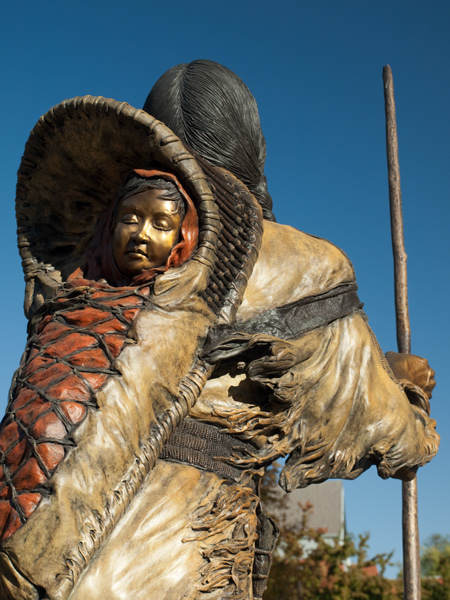At Fort Mandan below the Knife River Villages, Sacagawea gives birth to her first baby—Jean Baptiste Charbonneau—after a tedious and painful labor. Hunting about 40 miles to the south, Clark starts back towards the fort.
Little ‘Pompy’ Charbonneau
by Yellowstone Public Radio[1]Originally aired weekdays by Yellowstone Public Radio during the Bicentennial observance of 2003-2006. Narrated by Hal Hansen. Scripts by Whit Hansen and Ed Jacobson. Produced by Leni Holliman. © … Continue reading
Sacagawea and Jean Baptiste
Carol Grende (1955–2009)
© 2009 by Kristopher K. Townsend. Permission to use granted under the Creative Commons Attribution-Share Alike 4.0 International license.
Rattlesnake Rattles
Historical interpretation by John W. Fisher and the Lewis and Clark Honor Guard. Photo © 2017 by Kristopher K. Townsend. Permission to use granted under the Creative Commons Attribution-Share Alike 4.0 International license.
Delivering Baby Charbonneau
about five oclock this evening one of the wives [Sacagawea] of Charbono [Charbonneau] was delivered of a fine boy. it is worthy of remark that this was the first child which this woman had boarn and as is common in such cases her labour was tedious and the pain violent
—Meriwether Lewis
Applying the Rattle of Snake
Mr. Jessome informed me that he had freequently adminstered a small portion of the rattle of the rattle-snake, which he assured me had never failed to produce the desired effect, that of hastening the birth of the child; having the rattle of a snake by me I gave it to him and he administered two rings of it to the woman broken in small pieces with the fingers and added to a small quantity of water. Whether this medicine was truly the cause or not I shall not undertake to determine, but I was informed that she had not taken it more than ten minutes before she brought forth perhaps this remedy may be worthy of future experiments, but I must confess that I want faith as to it’s efficacy.—
—Meriwether Lewis
Heading Home
8th Day
air keen halted at the old Camp we Stayed in on the 2d night after we left the Fort, expecting to meat the horses at this Place, killed 3 Deer, Several men being nearly out of Mockersons & the horses not returning deturmind me to return to the Fort on tomorrow
—William Clark
Weather Diary
State of the Ther. at rise
Weather Wind at rise
Thermt. at 4 oCk. P.M. Weather Wind at 4 oCk. P.M. River 8 [below 0] fair N W 2 [below 0] fair N W —Meriwether Lewis[2]To assist the reader, the editor of this web page has omitted the date column, merged the “State of the River at
rise” columns, and spelled out some abbreviations.
Experience the Lewis and Clark Trail
The Lewis and Clark Trail Experience—our sister site at lewisandclark.travel—connects the world to people and places on the Lewis and Clark Trail.
Plan a trip related to February 11, 1805:

Fort Mandan is a High Potential Historic Site along the Lewis and Clark National Historic Trail managed by the U.S. National Park Service. The North Dakota Department of Parks and Recreation manages a modern reconstruction and the Lewis and Clark Interpretive Center located at US Hwy 83 and ND Hwy 200A.
Knife River Indian Villages National Historic Site is a High Potential Historic Site along the Lewis and Clark National Historic Trail managed by the U.S. National Park Service. A unit of the National Park System, the site is located at 564 County Road 37, one-half mile north of Stanton, North Dakota. It has exhibits, trails, and a visitor center.
Notes
| ↑1 | Originally aired weekdays by Yellowstone Public Radio during the Bicentennial observance of 2003-2006. Narrated by Hal Hansen. Scripts by Whit Hansen and Ed Jacobson. Produced by Leni Holliman. © 2003 by Yellowstone Public Radio. |
|---|---|
| ↑2 | To assist the reader, the editor of this web page has omitted the date column, merged the “State of the River at  rise” columns, and spelled out some abbreviations. rise” columns, and spelled out some abbreviations. |




